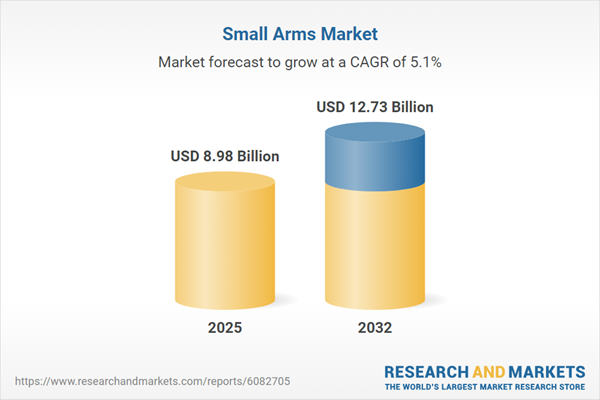Speak directly to the analyst to clarify any post sales queries you may have.
The global small arms market is transforming rapidly as technological innovation, evolving compliance requirements, and shifting procurement practices intersect. Senior decision-makers need actionable insights to navigate increasing operational and regulatory complexity, manage supply chains, and maintain competitive differentiation.
Market Snapshot: Small Arms Market Size & Growth
The Small Arms Market grew from USD 8.56 billion in 2024 to USD 8.98 billion in 2025. It is expected to maintain a compound annual growth rate (CAGR) of 5.07%, reaching USD 12.73 billion by 2032. This expansion reflects heightened demand across defense, law enforcement, civilian, and private security sectors as innovation and compliance pressures reshape manufacturer and supplier strategies.
Scope & Segmentation: Coverage Across the Value Chain
- Firearm Types: Handguns (Pistols, Revolvers), Machine Guns (Light Machine Guns, Submachine Guns), Rifles (Assault Rifles, Sniper Rifles), Shotguns
- Action Mechanisms: Automated, Manual (Bolt-action, Lever-action), Semi-Automated
- Calibers: 5.56 mm, 7.62 mm, 9 mm
- End-Use Segments: Civilian (Collectors, Hunters, Personal Defense Users), Commercial (Shooting Ranges, Training Facilities), Government Agencies (Law Enforcement, Military), Private Security (Bodyguards & Personal Protection Services, Security Firms)
- Regions: Americas (United States, Canada, Mexico, Brazil, Argentina, Chile, Colombia, Peru), Europe, Middle East & Africa (UK, Germany, France, Russia, Italy, Spain, Netherlands, Sweden, Poland, Switzerland, UAE, Saudi Arabia, Qatar, Turkey, Israel, South Africa, Nigeria, Egypt, Kenya), Asia-Pacific (China, India, Japan, Australia, South Korea, Indonesia, Thailand, Malaysia, Singapore, Taiwan)
- Key Technologies: Additive manufacturing, advanced polymers, integrated electronics, end-to-end traceability solutions, sensor fusion
- Leading Companies Assessed: ANDERSON MANUFACTURING, Carl Walther GmbH, Colt's Manufacturing LLC, Czech Small Arms, Daniel Defense, Fabbrica d'Armi Pietro Beretta, FN Browning Group, Glock, Heckler and Koch, Henry Repeating Arms, HS PRODUKT, Israeli Weapon Industries, Kalashnikov Concern, Kalyani Strategic Systems, Kimber Manufacturing, Mossberg & Sons, Radical Firearms, RemArms, Samsun Yurt Savunma, Savage Arms, Sig Sauer, Smith & Wesson, Springfield Armory, Steyr Arms, Sturm Ruger, Taurus Holdings, Heritage Manufacturing
Key Takeaways for Decision-Makers
- Integrated innovation and compliance are redefining competitive advantage, with modular platforms and electronics integration shifting product development and procurement criteria.
- Strengthened export controls, documentation demands, and regulatory traceability are compelling manufacturers to enhance information governance and scenario planning across supply chains.
- Segment differentiation by firearm type, action mechanism, caliber, and end-use is central; each requires tailored product design, training solutions, and compliance approaches for optimal market fit.
- Service-centric offerings, such as certified maintenance and modular training, are emerging as key channels for customer retention and recurring revenue in both government and commercial sectors.
- Successful entry and growth increasingly rely on region-specific commercial models that adapt to market preferences, local regulations, and logistical constraints.
Tariff Impact: Navigating 2025 Sourcing and Supply Shifts
US tariff measures introduced in 2025 created immediate pressure on sourcing strategies and component pricing. Many businesses accelerated localization of critical components and implemented dual-sourcing strategies, reducing dependence on single suppliers. These measures also affected product launch timing and highlighted the need for contingency planning and agile adaptation to regulatory shifts. Vertically integrated manufacturers with value-engineering capabilities are better positioned to absorb such shocks and maintain market stability.
Methodology & Data Sources
This research uses a triangulated approach, combining stakeholder interviews, technical analysis, and regulatory document synthesis. Structured interviews were conducted with procurement officials, technical specialists, and operations leaders. Patent reviews and open-source trade policies provided technology validation and industry context.
Small Arms Market: Why This Report Matters
- Enables decision-makers to align operational, compliance, and supply-chain practices with market-shaping trends and segment-specific demands.
- Supports strategic investment in modular, upgradeable platforms aligned with both regional regulations and end-user requirements.
- Provides actionable benchmarking for developing resilient procurement models and tailored after-sales strategies in diversified markets.
Conclusion
The small arms industry demands integrated innovation, strengthened compliance, and supply-chain resilience. Organizations that adapt to these imperatives will secure lasting value and maintain relevancy across evolving global markets.
Table of Contents
3. Executive Summary
4. Market Overview
7. Cumulative Impact of Artificial Intelligence 2025
Companies Mentioned
The companies profiled in this Small Arms market report include:- ANDERSON MANUFACTURING
- Carl Walther GmbH
- Colt's Manufacturing LLC
- Czech Small Arms, s.r.o.
- Daniel Defense Inc.
- Fabbrica d'Armi Pietro Beretta S.p.A.
- FN Browning Group
- Glock Ges.m.b.H
- Heckler and Koch GmbH
- Henry Repeating Arms
- Heritage Manufacturing, Inc.
- HS PRODUKT d.o.o.
- Israeli Weapon Industries by SK Group
- JSC Kalashnikov Concern
- Kalyani Strategic Systems Ltd.
- Kimber Manufacturing, Inc.
- O.F. Mossberg & Sons
- Radical Firearms, LLC.
- RemArms LLC.
- Samsun Yurt Savunma sanayi ve Ticaret A.Ş
- Savage Arms, Inc.
- Sig Sauer, Inc.
- Smith & Wesson Brands Inc.
- Springfield Armory Inc.
- Steyr Arms GmbH
- Sturm, Ruger & Co., Inc.
- Taurus Holdings, Inc.
Table Information
| Report Attribute | Details |
|---|---|
| No. of Pages | 193 |
| Published | November 2025 |
| Forecast Period | 2025 - 2032 |
| Estimated Market Value ( USD | $ 8.98 Billion |
| Forecasted Market Value ( USD | $ 12.73 Billion |
| Compound Annual Growth Rate | 5.0% |
| Regions Covered | Global |
| No. of Companies Mentioned | 28 |









